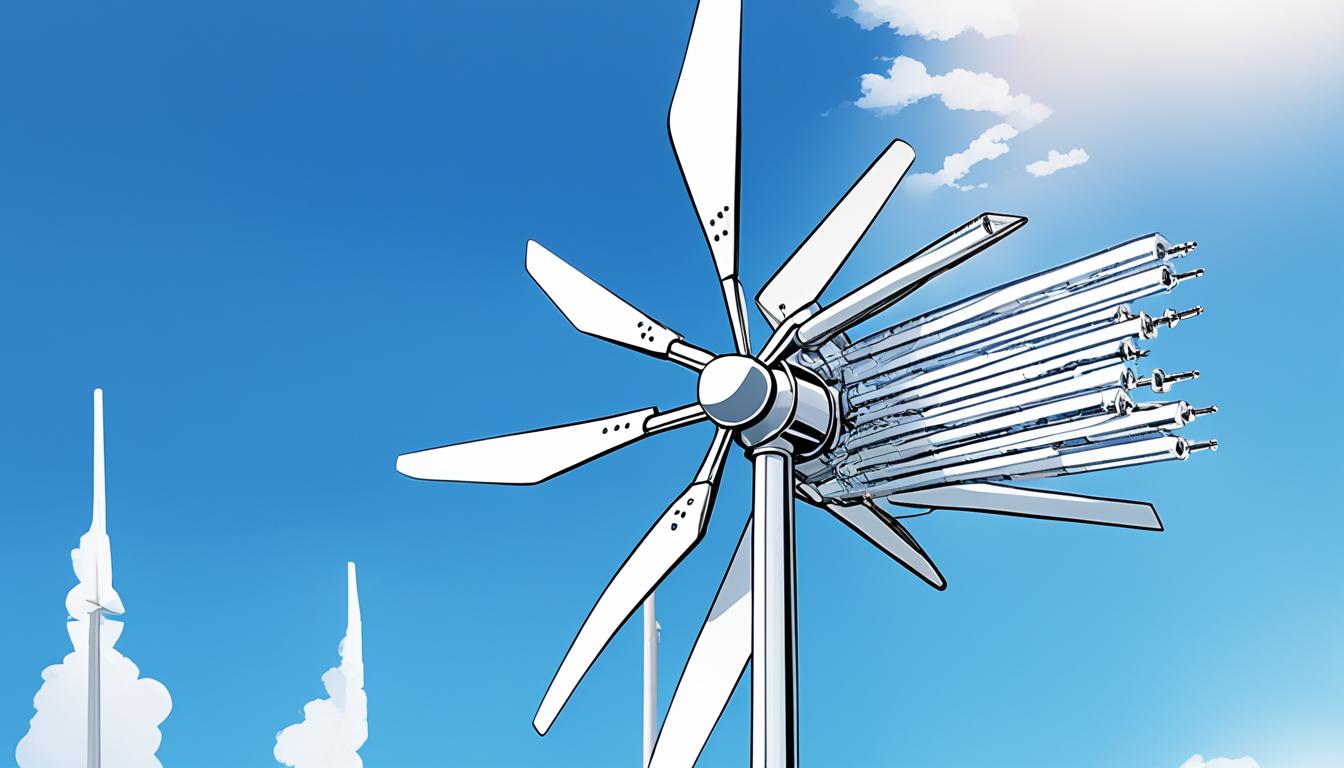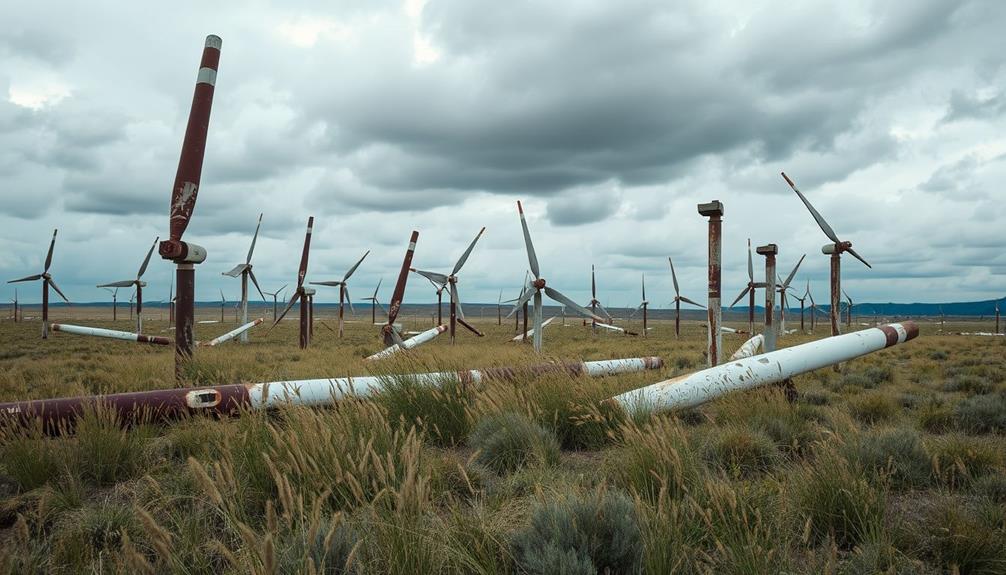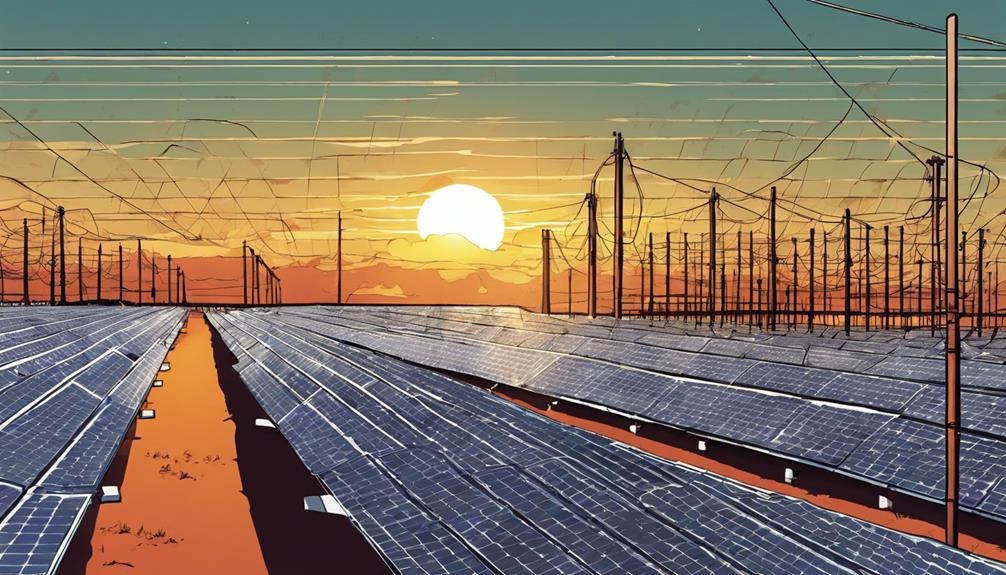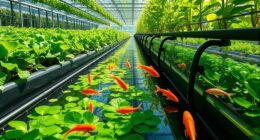Did you know wind power is clean energy? It creates no harmful greenhouse gases1. Many people are turning to wind turbines and windmills for power. They catch the wind’s power to make electricity, playing a big part in clean energy use.
Places like coasts, hilltops, and wide, open plains are great for windmills and turbines1. They are cheap to run over time and last long. Windmills can power small homes or even whole towns.
To figure out how much power wind can make, we look at wind speed, the turbine’s size, and how well it works1. It helps decide where and how big the turbines should be to get the most power.
Before putting up wind turbines, you have to follow local rules and look at their environmental impact1. Finding the right place needs thinking about the land, animals, plants, and if people nearby support it.
Key Takeaways:
- Wind power is a renewable energy source that contributes to a cleaner environment1.
- Areas with consistent and strong wind currents are ideal for windmill installations1.
- Windmills have low operating costs and a long lifespan, making them a cost-effective energy generation option1.
- Calculating energy generation from wind involves factors such as wind speed, turbine size, and efficiency1.
- Compliance with local regulations and environmental assessments is crucial for identifying suitable windmill installation sites1.
The Working Principle of Windmills
Windmills, also called wind turbines, change the wind’s power into electricity. They turn kinetic energy from the wind into mechanical energy and then into electricity.
The main parts of a windmill are rotor blades, a generator, and a transmission system. Rotor blades catch the wind’s energy. This makes the rotor spin, like how a fan works. The spinning rotor connects to a generator. This changes the mechanical energy into electricity. Then, this electricity goes through a network for use in different ways.
There are many sizes and types of windmills. They vary based on their purpose and where they are. Land-based turbines can be from 100 kilowatts to several megawatts. Bigger turbines in wind plants are more cost-effective2. Offshore turbines are huge and stand taller than the Statue of Liberty. They catch strong ocean winds to make a lot of energy2. Small wind turbines, under 100 kilowatts, are used for homes, farms, and small businesses2. There are also hybrid wind systems. They combine wind with diesel generators, batteries, and solar power. They are used in remote areas and for connected grids to be more reliable2.
Wind power has grown from old windmills to today’s advanced turbines2. Modern wind farms use wind energy for many purposes. This helps more people adopt renewable energy sources2.
The Benefits of Windmills
Windmills offer many benefits, such as clean and renewable energy. They are great for reducing harmful gases and fighting climate change. Windmills help us be more self-sufficient and save money over time.
Windmills also create lots of jobs, boosting the economy. In the U.S., the wind industry employs over 125,000 people. This can grow to support even more jobs by 20503. These jobs added $20 billion to the U.S. economy in 20223.
Wind energy from turbines accounts for more than 10% of the U.S.’s energy production in 20223. This shows how effective windmills are in diversifying our energy sources.
Windmills are good for the environment too. They help avoid millions of metric tons of carbon dioxide each year. In the U.S., this is like taking 73 million cars off the road3.
From a financial point of view, wind projects are very beneficial. They generate about $2 billion each year for local and state governments3. This money helps improve local communities.
Furthermore, wind energy is one of the cost-effective sources we have. It’s great for rural and remote areas with lots of wind3. These projects make the most of our natural resources.
Advances in wind technology have made it more efficient. Wind and solar projects are now affordable compared to other energy sources. Though, the availability of wind can vary the costs34. By improving our power grids, we can lower the costs of wind energy even more3.
Wind turbines have less impact on wildlife than other energy projects. It’s important to keep researching to reduce these impacts even more. Properly placing wind farms helps protect birds and bats345.
In summary, windmills offer lots of pluses. They give us clean energy, create jobs, help the economy, lower emissions, and are cost-effective. With ongoing advancements, wind energy will continue to be vital for our future.

Appropriate Installation Locations for Wind Turbines
Choosing where to put wind turbines involves a few key things. These include the wind itself, enough clear space, and rules to follow. Picking the right spot is vital for getting the most energy while protecting nature. We’ll look into what makes a spot good for wind turbines.
Wind Resources
For wind turbines to work well, areas need strong, steady winds. The Great Plains, Midwest, and coastal areas of the United States are ideal6. These spots have lots of wind, which means more power can be made. The Great Plains have wide-open spaces that let wind flow freely6. Coastal areas offer strong sea winds and the right landscape for catching wind6.
Unobstructed Space
Wind turbines need space without barriers to catch wind well. Places like hilltops, open fields, and coasts are perfect. They let turbines get as much wind as possible for power. Also, if turbines are within 30 kilometers of a place, they don’t mess up the view much7.
Regulatory Considerations
Following local rules and studying the environment is a must for placing wind turbines. They should be near big power lines and main roads but not too close to protected lands7. Looking at wind patterns, how close they are to power lines, and land use is critical for good energy production and meeting rules6.

The list below shows the top five states making the most wind electricity in the U.S. in 2023. These states highlight the importance of careful planning in making more energy and bringing in money:
| Rank | State | Wind Electricity Generation (2023) |
|---|---|---|
| 1 | Texas | Texas was at the forefront of wind power, making about 13% of the U.S. wind electricity in 20238. |
| 2 | Iowa | Iowa helped a lot with wind power, adding more than 9% to the U.S. total in 20238. |
| 3 | Oklahoma | Oklahoma played a big role, making over 8% of the U.S. wind electricity in 20238. |
| 4 | Kansas | Kansas contributed significantly, providing more than 7% of the U.S. wind electricity in 20238. |
| 5 | Illinois | Illinois was a top wind power state, with about 6% of the U.S. total in 20238. |
Choosing sites for wind turbines uses advanced tech like lidar and GIS6. These help figure out the best places for the turbines by looking at wind and the land. By thinking about the wind, space, and rules, turbines can be put in places that make lots of energy without harming the environment6.
Calculation for Energy Generation
To estimate the energy wind turbines can generate, we consider wind speed, turbine size, and efficiency. Knowing these helps us predict how much power we can get. It makes choosing the right setup for wind energy projects easier.
At the heart of these calculations is a key formula:
Power = 0.5 x Area x Air Density x Wind Speed3 x Efficiency9
This formula factors in the turbine blades’ swept area, the air’s density, wind speed, and turbine efficiency. We’ll take a closer look at each to understand their impact on generating energy.
Swept Area
The area the turbine blades cover as they spin is the swept area. It’s found using this equation:
A = π x R29
The formula shows that a longer blade catches more wind, boosting energy capture. Here, “A” stands for the swept area and “R” for the blade’s length.
Air Density
Air density is crucial in wind power calculations. It’s usually set at 1.225 kg/m3, considering standard atmospheric pressure and temperature. This factor influences how much wind a turbine can harness.
Wind Speed
Wind speed greatly affects a turbine’s energy output. The energy from wind is given by:
Ew = (1/2) x π x R2 x ρ x v3 x t9
This shows how the wind’s speed, especially when cubed, plays a major role in energy generation. Faster winds mean more power.
Turbine Efficiency
A turbine’s efficiency is about its ability to turn wind into electricity. Efficiency varies based on design and operation. For instance, a 40% efficient turbine’s energy output is calculated as follows:
Ewt = (ηwt / 100) x Ew9
Here, “Ewt” is the energy a wind turbine produces, and “Ew” is the wind energy. Adjusting inputs like wind speed and turbine size estimates the energy output. For a 10m blade turbine running at 40% efficiency for 3 hours, it produces roughly 60133630.684 Joules9.
Types and Evolution of Wind Energy Technology
Over the years, wind energy technology has greatly improved. These improvements have made wind turbines more efficient and powerful. Today, they produce a lot of clean, renewable energy. This helps us build a sustainable future.
There are two types of wind turbines: horizontal-axis and vertical-axis. The most common type, horizontal-axis turbines, have blades like a fan and stand on tall towers. West, 2022 explains that these towers can be as tall as 20-story buildings, with blades over 100 feet long. Vertical-axis turbines have a vertical rotor and can catch wind from any direction, without needing to pivot.
Most people prefer horizontal-axis turbines because they work better and produce more power. West, 2022 points out that thanks to new designs and technology, these turbines are very efficient. They are perfect for big wind farms. The biggest wind turbines now can generate up to 15,000 kilowatts of power.
By the end of 2022, some big wind projects showed how much wind power has grown. The Highland Wind Project in Iowa has 462 turbines, making 502 megawatts of power. West, 2022 notes that the Grand Prairie Wind project in Texas is even larger. It has 365 turbines with a capacity of 1,027 megawatts.
Wind energy technology keeps getting better, thanks to ongoing research and investment. New testing facilities and studies about wind’s impact on wildlife and the environment are making turbines more efficient and reliable. According to West, 2022 and Taylor, 2022, these efforts are helping wind power grow worldwide.
Evolving Wind Energy Technology: Statistical Overview
| Statistical Data | Source |
|---|---|
| Small wind turbines for individual homes may have an electric-generating capacity of 10 kilowatts (kW). | 10 |
| The largest operating wind turbines can have an electric-generating capacity of about 15,000 kilowatts (15 megawatts), with larger turbines in development. | 10 |
| Horizontal-axis turbines can reach heights equivalent to 20-story buildings with blades extending over 100 feet long. | 10 |
| Nearly all operating wind turbines are horizontal-axis turbines due to their performance superiority over vertical-axis turbines. | 10 |
| As of the end of 2022, the Highland Wind Project in Iowa had 462 wind turbines with a total generating capacity of about 502 megawatts (502,000 kilowatts). | 10 |
| The Grand Prairie Wind energy project in Texas had the largest total nameplate capacity, totaling 1,027 MW (approximately 1 million kilowatts) with 365 wind turbines. | 10 |
| Over 30 years, research funded by the Wind Energy Technologies Office has addressed wind energy’s effects on wildlife and the environment. | 11 |
| The Wind Turbine Verification Program, established in 1993, introduced electric utilities to emerging wind turbine technologies, contributing to increased confidence in wind power and fostering its growth. | 11 |
| The DOE-NASA Mod-Series Wind Turbine Program, running for over two decades and involving the construction of five distinct models, significantly influenced the development of a cost-competitive wind energy industry in the United States. | 11 |
| The Wind Energy Technologies Office (WETO) has invested in blade and drivetrain testing facilities since the 1990s to advance wind turbine efficiency and reliability, benefiting both domestic and global expansion of commercial wind power. | 11 |

The Role of Aerodynamics and Weather Patterns in Wind Energy
Understanding aerodynamics and weather patterns is key to using wind power. Engineers use their knowledge to make better wind turbine blades12. These blades vary in shape, length, and tilt, which affects how much power the turbine can make. With these designs, wind turbines can use the wind more effectively.
Weather patterns are vital for wind energy. They help engineers pick the best spots for wind farms and keep them running well. It’s crucial to find places with steady and good wind speeds. Wind turbines need at least 14 miles per hour to work well, but smaller ones can manage with 6-9 mph winds12. The best places for turbines are where winds are 16-20 mph, ideally at 50 meters high12.
Weather also causes changes in how much electricity turbines can make through the year. In winter, turbines can make 50% more energy because the cold air is denser. Yet, these changes can differ based on where the wind farm is12.
Engineers rely on tools like anemometers to understand the weather. These gadgets measure wind’s speed, force, and direction. They help in planning where to put wind turbines. However, anemometers can be about 1% wrong in their readings13. Any mistakes in wind speed can greatly change power estimates. For example, if wind speed is overestimated by 10%, the expected power could be 33% too high12.
Engineers also think about how wind turbines affect the environment. They design turbines to handle tough weather. Wind turbines in Maine, for instance, work even at -40°C. They have special blade coatings to stop ice from forming12. Engineers also try to make turbines that bugs can’t stick to12. This helps keep the turbines running smoothly.

Aerodynamics in Wind Energy
The image above shows why aerodynamics are crucial in wind energy. Engineers use aerodynamics to improve wind turbine blade designs. This lets us get more power from the wind.
Wind energy affects the environment too. Wind farms need to be built with care to avoid harming birds like the golden eagle. It’s important to plan well to reduce any negative effects on wildlife12.
The impact of aerodynamics and weather on wind energy is huge. It helps make sure turbines work well, gives accurate energy predictions, and keeps the environment safe1213. By learning more about aerodynamics and weather, engineers can make wind energy better.
The Global Impact of Wind Energy
Wind energy is changing how we make electricity, offering a green alternative to traditional methods. Countries are using wind energy to move towards a cleaner future. It’s a key part of reaching renewable energy goals.
Statistical data14 shows wind energy is the top renewable energy source in the U.S. It’s plentiful and has a small environmental footprint, making it great for cutting down greenhouse gases. Wind could supply 20% of U.S. electricity by 2030 and 35% by 2050, reducing fossil fuel use while meeting energy needs.
Environmental Impact
Wind energy is cleaner than gas and coal when we look at global warming emissions15. Wind turbines emit 0.02 to 0.04 pounds of CO2 per kilowatt-hour. That’s much less than gas generators and coal plants.
Using wind energy can lower our carbon footprint and help tackle climate change. Wind farms use little land, preserving natural habitats. Offshore wind farms, though expensive, have high potential for wind power16.
Economic Impact
Wind energy boosts local economies and creates jobs. In 2021, the U.S. wind industry employed over 120,000 people and had manufacturing at more than 500 sites16. This growth supports economic development and sustainability.
Wind energy is now an affordable electricity source14. Turbine costs have dropped, and wind energy contracts are cheaper than average residential electricity prices in 2021. This makes wind energy a cost-effective choice for many16.
Global Potential
Wind energy has a huge potential worldwide. In 2022, it provided 10.2% of U.S. electricity16. Yet, the U.S. has far more wind to harness, with 43,000 TWh available compared to 4,048 TWh used in 202216.
Worldwide, wind capacity reached 906 GW in 2022, growing by 12% annually16. Continued support and technology improvements are expanding wind’s impact, helping meet renewable energy targets.
Supporting wind energy also helps the environment beyond just making electricity. By investing in renewable energy certificates (RECs), people and businesses can promote green energy. This supports the shift to cleaner energy sources16.

In summary, wind energy is crucial for a sustainable future. It’s a clean, cost-effective way to achieve renewable energy goals. With benefits like low emissions, job creation, and reducing greenhouse gases, wind energy is a key player in combating climate change. Choosing wind power advances the move to a greener planet and strengthens economies and energy security.
Wind Energy Policies and Market Dynamics
Supportive policies and clear regulations are key to growing wind energy. Governments around the world set renewable energy goals. They want to boost investments in wind power. They offer special deals, tax breaks, and financial benefits. These help build wind energy setups and new technologies. By doing this, they push for a future with less fossil fuels and more clean energy, like wind power17.
The wind energy market is also booming. Thanks to cheaper and better wind turbines, wind energy is a top choice in the energy market. More people and businesses want clean, sustainable energy. Wind power is perfect for this. It can be scaled up or down, fitting both big farms and small community projects. This leads to more jobs, innovation, and economic growth in windy areas18.
Let’s look at some numbers to understand the impact better. In 2021, the U.S. added 13,413 megawatts (MW) of wind power. This increase brought the total to 135,886 MW. This growth was backed by a $20 billion investment. Wind energy makes up over 9% of the U.S. electricity. In some states, it’s even over 30% or 50%. The new wind turbines added have an average power of 3 MW. That’s a 9% jump from 2020. Since 1998-1999, there’s been a 319% increase. The U.S. is also focusing on offshore wind projects. The offshore wind pipeline reached 40,083 MW in 2021. Also, the world added 17,398 MW of offshore wind power, totaling 50,623 MW across 257 projects. In the U.S., distributed wind added 11.7 MW in 2021, reaching 1,075 MW in total from over 89,000 turbines17.
These numbers show the good wind energy policies and market can do. As wind power grows, so do job opportunities and economic benefits. Over 125,000 people worked in the U.S. wind industry in 2022. Wind projects on private lands paid about $935 million in land leases, helping rural owners and communities. Additionally, the wind sector paid roughly $1 billion in taxes in 2022. This money goes to public revenues and services. Wind farms pay landowners in different ways, benefitting everyone involved. There are also incentives for investing in wind projects at all levels. Community wind projects benefit local residents by creating jobs and diversifying electricity sources18.
The wind energy market is set to grow by 10.67% CAGR, a report says. Offshore turbines, which have higher efficiency than onshore ones, are becoming more popular. In 2020, China installed half of the new offshore wind capacity worldwide. Other important countries include the UK, Germany, and China. The need for renewable energy, especially in remote areas, drives the market. In 2020, China was the leader in new onshore wind power. It installed 48.94 GW, reaching a total of 278.32 GW. India aims to install more wind power, reaching a target of 60 GW. The U.S. plans seven major offshore wind projects, aiming to power 10 million homes by 203019.
Wind Energy Market Comparison
| Statistic | Value |
|---|---|
| U.S. Total Installed Wind Capacity | 135,886 MW |
| Global Total Offshore Wind Capacity | 50,623 MW |
| U.S. Wind Industry Employment in 2022 | Over 125,000 workers |
| Land Lease Payments to Rural Landowners in 2022 | $935 million |
| State and Local Taxes Paid by U.S. Wind Industry in 2022 | $1 billion |

Wind energy policies and market trends help wind power grow worldwide. Support from governments and economic benefits encourage investments in wind energy. This makes wind energy a strong option for clean electricity. Jobs are created, and costs drop as wind energy advances. Adapting policies and tapping into market dynamics are crucial for wind power’s long-term victory.
Conclusion
Wind energy is vital for a sustainable future. It is a major force in moving towards renewable energy. Stats20 show that wind turbines could meet about 10% of the U.S.’s electricity needs if used properly. This shows how important wind energy is for cutting carbon emissions and cleaning our environment.
Recently, wind turbine technology has improved a lot. According to data21, turbines with six blades make more power than others. This was surprising because it was thought that three blades would work best. These improvements highlight the ongoing advancements in wind turbine design.
History22 tells us wind energy technology has evolved significantly since the first wind turbine in Ohio in 1888. Today’s wind turbines are tall, reaching 30 to 100 meters, to catch better winds. They also use advanced technology to be more efficient, affordable, and long-lasting than old windmills and pumps.
For wind energy to reach its full potential, countries and industries must invest in research and development. Even though the U.S. wind power industry faces challenges, such as fewer installations and financial issues, recognizing wind energy’s importance is critical. With fossil fuels running low and people more worried about the environment, developing wind power is key for a greener future.










